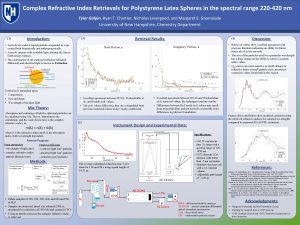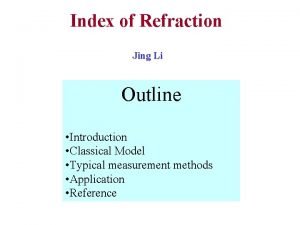Complex Refractive Index Retrievals for Polystyrene Latex Spheres

- Slides: 1

Complex Refractive Index Retrievals for Polystyrene Latex Spheres in the spectral range 220 -420 nm Tyler Galpin, Ryan T. Chartier, Nicholas Levergood, and Margaret E. Greenslade University of New Hampshire, Chemistry Department Introduction: (1) • Aerosols are solid or liquid particles suspended in a gas created both biogenically and anthropogenically. • Aerosols interact with available light, altering the Sun to Earth energy balance. • The combination of all scattered (reflected, refracted, diffracted) and absorbed light is known as Extinction. Reflected Retrieval Results: (3) (4) Imaginary Portion, k Real Portion, n Refracted Absorbed and Reradiated Discussion: • Retrieved values show excellent agreement with previous literature indicating an ability for future retrievals of in situ aerosols. • The size of the particles used for a particular wavelength has a huge impact on the ability to retrieve accurate index values. • Qext curves are most sensitive to small changes in refractive index at small particle sizes; measured extinction values should fall in this region. Diffracted http: //www. slideshare. net/HORIBA/advanced-laser-diffraction-theory Extinction is dependent upon: • Composition • Size and shape • Wavelength of incident light Mie Theory: Absorption and scattering of light by spherical particles can be calculated using Mie Theory. Important to the calculations and the work shown here is the complex refractive index, m, • Excellent agreement between DOAS, Washenfelder et al. , and French et al. values. • Ma et al. values differ since they are extrapolated from previous measured values using Cauchy coefficients. (2) • Excellent agreement between DOAS and Washenfelder et al. retrieved values, the techniques used are similar. • Differences between the French et al. values may result from using thin films and not aerosols, or possibly from differences in polymer formulation. Instrument Design and Experimental Data: where n is the refractive index and k is the absorption index, both wavelength dependent. Specifications: Fortran Program: Input parameters - wavelength of light (nm) - complex refractive index - particle diameter (nm) Output coefficients - scattered light (cm 2/particle) - absorbed light (cm 2/particle) - extinction (cm 2/particle) Methods: The average calculated extinction (cm-1) of 6 trials for 150 nm PSLs using a path length of 19. 51 m. AE-DOAS • Dilute samples of 150, 220, 300, 430, and 600 nm PSL in H 2 O • Samples are atomized, dried, size selected (DMA), measured for extinction (AE-DOAS) and counted (CPC) • Using an iterative process the complex refractive index is retrieved RESEARCH POSTER PRESENTATION DESIGN © 2015 www. Poster. Presentations. com Figures above and below show modeled extinction using the retrieved refractive indices for selected wavelengths compared to measured DOAS PSL extinction. ― 100 W continuous duty Xe lamp with a spectral range of 2201050 nm ― 3072 element LDA detector with better than. 5 nm resolution ―Stainless steel gas cell with a 4 L internal volume ―Adjustable path length of ~2 -20 m References: Bohren, C. F. and Huffman, D. R. : Absorption and scattering of light by small particles, Wiley Professional Paperback Series, Wiley-Interscience, New York, USA, 1983. Chartier, R. T. , Greenslade, M. E. , Initial investigation of the wavelength dependence of optical properties measured with a new multi-pass Aerosol Extinction Differential Optical Absorption Spectrometer (AE-DOAS). Atmos. Meas. Tech. , 2012. French, R. H. ; Winey, K. I. ; Yang, M. K. ; Qiu, W. M. , Optical properties and van der Waals London dispersion interactions of polystyrene determined by vacuum ultraviolet spectroscopy and spectroscopic ellipsometry. Aust. J. Chem. , 2007. Ma, X. , Lu, J. Q. , Brock, R. S. , Jacobs, K. M. , Yang, P. , Hu, X-H. , Determination of complex refractive index of polystyrene microspheres from 370 to 1610 nm, Phys. Med. Biol. , 2003. Washenfelder, R. A. ; Flores, J. M. ; Brock, C. A. ; Brown, S. S. ; Rudich, Y. , Broadband measurements of aerosol extinction in the ultraviolet spectral region. Atmos. Meas. Tech. , 2013. Acknowledgments: • Margaret Greenslade and the Greenslade Group • Funding for research from a CEPS start-up • UNH Graduate School and UNH Chemistry Department for travel expenses

